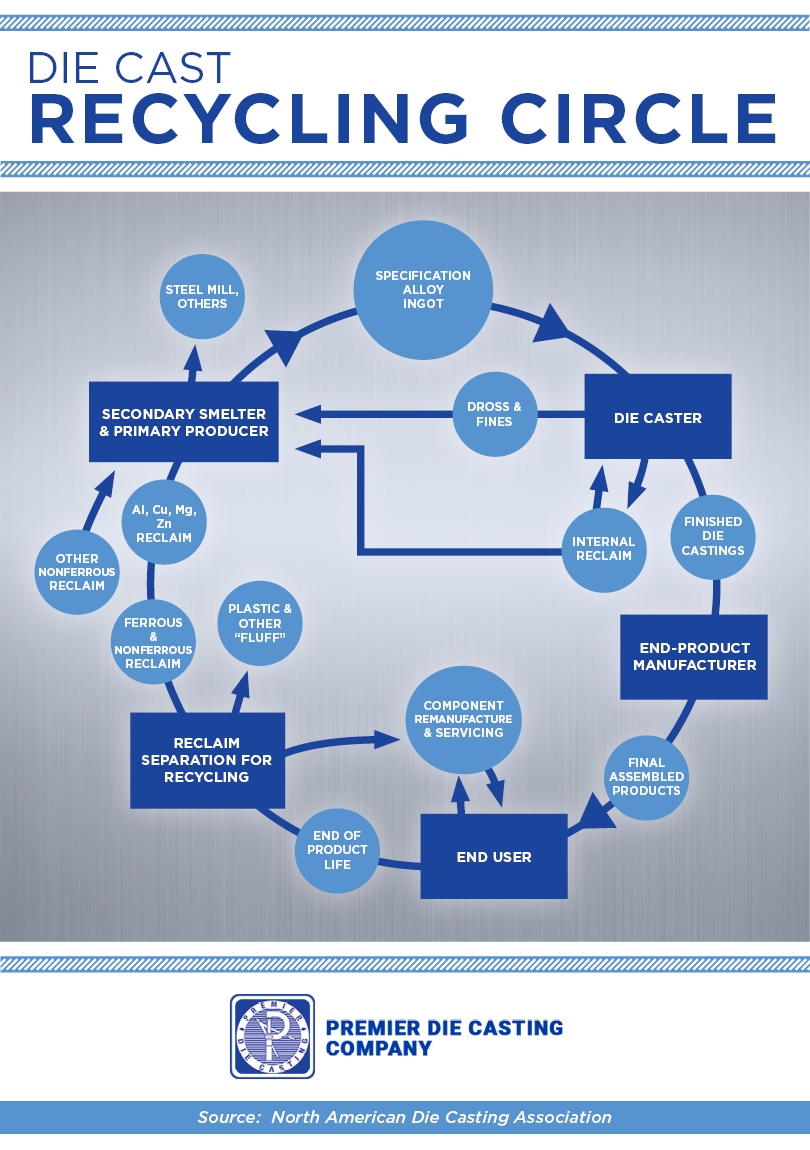
One of the many benefits of die casting is that it is eco-friendly. Die casting can reduce waste and make use of recyclable materials. If you have been curious about how your company can be more environmentally conscious, learn more about environment-friendly die casting.
How Is Die Casting Environmentally Friendly?
There are a number of factors that make die casting the most environmentally friendly choice when it comes to metal casting. For one, when you make a die, you can use it over and over again. Other metal casting methods such as sand casting require you make a sand mold, which you must repress after every casting. This wastes a huge amount of energy and the used sand needs to be reclaimed or disposed of properly.
A die, in contrast, you can use tens of thousands of times. Also, die casting makes use of many recyclable materials. Other environmentally friendly initiatives related to die casting can include re-using excess die lube rather than letting it flow into waterways, and testing contact water for oil, grease, metals or excess suspended solids, as well as testing pH levels frequently.
What Are Some Die Casting Recyclables?
Just about everything involved in the die casting process is recyclable. The die itself is recyclable and specialty mills can retool them once they have outlived their usefulness. The material we most commonly use in die casting production is aluminum, and aluminum is completely recyclable. In fact, half of the aluminum in this country comes from recycled material.
In addition to being affordable, aluminum can be a very energy-efficient choice, since aluminum casting can produce a lot of usable material with relatively low energy. Something on the order of 95 percent of aluminum die castings use only recycled material. Die casting with aluminum means a reduced carbon footprint, less excess material sent to landfills and less active mining.
What Is High Porosity and Why Is It a Problem?
Porosity, put simply, means holes in your product. It leads to greater waste because parts you produce with too many holes are ones you need to discard. While you may find some porosity in any cast metal and it does not always mean the part is useless, the more porous a finished product is, the more likely it is that the part will have structural integrity deficits that render it unusable.
Porosity occurs when the die casting process allows air to get into the metal during the die casting operation. Metal casters use a hydraulic ram with a piston to force molten metal into the die mold, and while there are vents and overflows to allow this air to escape, it is not always completely effective. High porosity can be a result of a number of factors, including poor mold design, low purity in the alloy, the pressure and shot speed of your die casting machines, material wall shrinkage or an excess of die lubricant.
Die Casting in the U.S. vs. China
American die casting companies like Premier Engineered Products use a variety of methods to dramatically reduce metal porosity in die casting. Those methods include making sure equipment is properly maintained to produce stability throughout the casting process so that there is even and sufficient pressure from beginning to end. Die casters can also avoid air bubbles forming inside the casting while it cools by melting the material in a vacuum-sealed environment, using a vacuum system to reduce air entrapment in the mold, or increase final pressure on the metal as it solidifies.
While these methods make the entire die casting process more complex, it also makes it much more eco-friendly than the die casting methods you will find in China. Overseas, many die casters tend to use aluminum high-pressure die casting methods that allow for a simplified casting process but produce higher porosities. This means more defective parts that need to be discarded and greater waste.
Low porosity casting also means the parts that do meet structural integrity requirements are more likely to last. No matter where you get your die cast parts, they may come with some level of porosity deemed acceptable by industry standards, so it can be to your benefit to seek out a die casting company that makes an effort to minimize or eliminate porosity from your parts. At Premier we utilize a vacuum system in our dies to assist in evacuating the air trapped during the injection of the aluminum.
More Information About Eco-Friendly Die Casting
In addition to being the most environmentally friendly form of metal shaping, we think you will find it is the most efficient and produces the most high-quality parts. Die casting is ideal for companies that do a lot of metal stamping, fabrication, and assembly since it produces less scrap waste, which is better for the environment. Die casting also allows you to make complex shapes with tighter tolerances and is faster than other methods. This can be a great benefit if you are doing high-volume part production.
To learn more about die casting and how it is better for the environment, or about how Premier Engineered Products can meet all of your metal fabrication needs with high-quality, low-porosity casting service and reliable parts, contact Premier Engineered Products now.
More of a visual learner? Check out this helpful graphic which details the die casting recycling circle.


